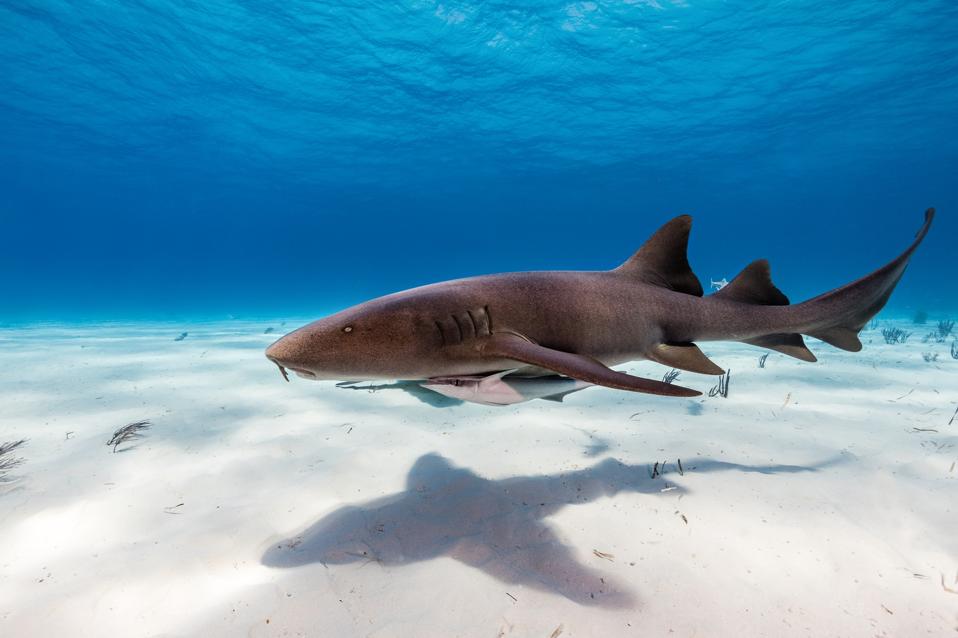A flash of gold in the watery depths is not what most divers, fishers, or beachgoers expect to see. Even if you’re a seasoned gold hunter, the ocean is not usually the first place one thinks of, especially not when talking about a predator that has been around for millions of years. Sharks tend to blend into their surroundings with shades of grey, brown, or sandy beige, a camouflage perfected since they’ve been around. Yet off the coast of Tortuguero National Park in Costa Rica, a sport fishing trip in 121 feet (37 meters) of water led to a quite unusual find: a nurse shark glowing with an intense yellow-orange coloration. At roughly 6.6 ft (2 m) in length, the adult shark was an unmistakable outlier in a species known for its subdued coloration.
What’s responsible for this striking appearance? According to a newly published scientific article, a phenomenon called “xanthism,” a pigmentation condition that results in an excess of yellow or golden tones in the skin, scales, or fur of animals. While xanthism has been recorded in marine species — in quite a few species of fish, for example — it had never before been scientifically reported in any cartilaginous fish in the Caribbean, which includes the sharks, skates, and rays. This specimen represents the first confirmed case in the region and, even more remarkably, the first fully xanthic nurse shark ever documented anywhere!
Sharks like the nurse shark (Ginglymostoma cirratum) are benthic predators, meaning they spend much of their time on or near the seafloor, often around reefs and rocky ledges. Their usual brownish tones help them blend with the substrate, making them less conspicuous. The bright yellow-orange coloring on this specimen? Well, it would have made it stand out in such environments, which makes its survival (especially into adulthood!) particularly intriguing. It’s unknown whether the shark’s unusual appearance has any adaptive advantages, or if it simply managed to thrive despite being more noticeable. Reports of abnormal pigmentation in nurse sharks are rare, but not unheard of; scientific literature contains isolated cases of albinism, piebaldism (patchy coloration), and hypomelanosis (reduced pigment), each representing a deviation from their standard pebbled color. Albinism in sharks is itself a rare occurrence and can is thought to be possibly detrimental because the lack of dark pigments reduces camouflage, making the animal more visible to predators or prey, and impacting their ability to mate with others of its species.
This new find adds xanthism to the list, and opens the door to further questions about what triggers such anomalies. Could the pigmentation be the result of a spontaneous genetic mutation affecting pigment-producing cells, or might it be inherited through a recessive trait that only rarely appears? Could diet (such as the consumption of prey rich in certain pigments) play a role, as it does in some birds? Or do environmental stressors, pollutants, and changes in water chemistry influence pigment expression in sharks the way they sometimes do in other marine species (like coral)? It also makes one wonder if this different coloring can affect the shark’s behavior, camouflage, or ability to find a mate. These are just some of the questions that showcase just how much we still have to learn about pigmentation in nature, but especially for animals like sharks since these events are so seldom recorded.
Without tissue sampling and genetic testing, the exact cause remains speculative.
But there was more to this shark’s golden hue than just xanthism. The unusual sunny color was paired with striking white eyes, a clue that the shark also has albino-xanthochromism. Albino-xanthochromism, a rare combination of two pigment conditions, occurs when albinism disrupts the production of melanin (i.e. the dark pigment responsible for shades of black, brown, and grey) while xanthism simultaneously intensifies yellow to orange tones by altering the deposition of other pigments, such as carotenoids or pteridines. When melanin is absent, the underlying yellow or orange pigments become far more visible, giving the animal a vivid, almost glowing appearance. This combination is unusual because it requires two separate pigment pathways to be affected at once, making it far less common than either albinism or xanthism on their own.
From a conservation perspective, cases like this serve as a reminder of the diversity and complexity within even well-known species as nurse sharks are generally common throughout the Caribbean and aren’t listed as endangered worldwide. Still, like many shark species, they face local challenges such as overfishing, habitat destruction, and disturbances caused by human activity. Protecting their populations means preserving not just their ecological role, but also the rare (and surprising) genetic variations that occur within them. Each anomaly — whether it be a white, spotted, or golden — represents a chapter in the species’ evolutionary story.
Fisheries pose a significant threat to shark populations worldwide, yet they also sometimes provide unexpected opportunities for discovery thanks to those who take the time to notice unusual individuals and share their observations. Without the curiosity to note something unusual and the diligence to report it, such phenomena might otherwise pass unnoticed. And in marine science, every anomaly is a potential key to understanding the broader puzzle of ocean life. Photographs and reports from such encounters can and do become valuable data points for researchers studying marine biodiversity. While a nurse shark’s golden glow might not change the course of marine biology overnight, it does expand the boundaries of what we know is possible — and that is the very essence of scientific discovery.

